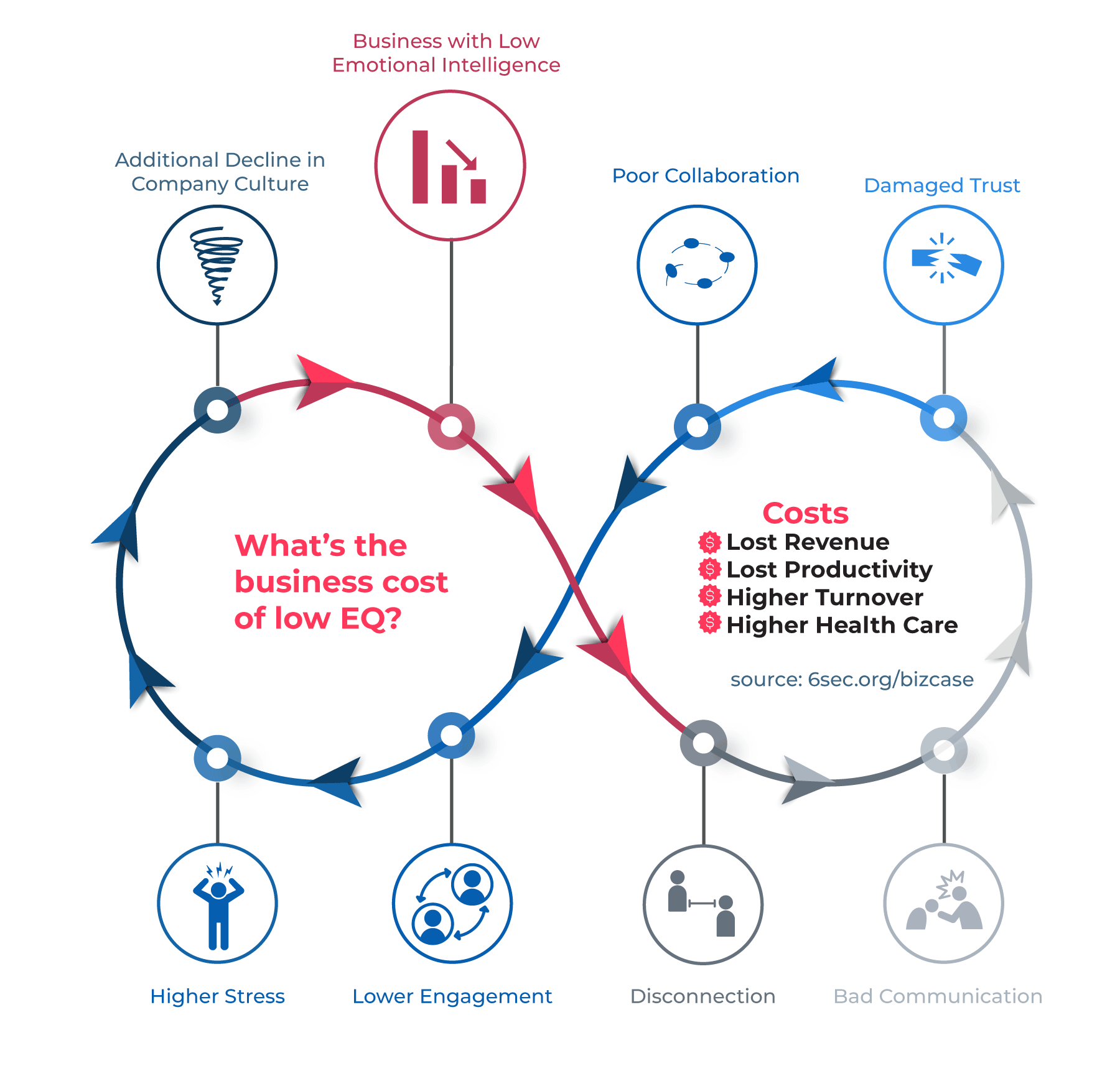How Much of the $1.8T Are You Losing?
4 Steps to Increase Engagement and Reduce Turnover with Emotional Intelligence
Is the competitive advantage you’re searching for right in front of you?
For decades, companies have tried to fix weak employee engagement through rational systems and transactional perks – but that’s not enough because the problems are fundamentally emotional. And it’s getting worse: The alarm is sounding from the World Health Organization, World Economic Forum, US Surgeon General and more: people are in deeper distress than a decade ago, and businesses are losing value as a result.
Here’s a 4-step plan to use emotional intelligence to better support your people, improve retention and productivity, and fuel sustainable high performance.
A $1.8 trillion problem – and a solution hiding in plain sight
Even in today’s business environment when leaders are constantly searching for value, they often overlook their greatest source of that value – because they struggle to associate it with the bottomline. Most, if not all, businesses succeed as a result of its human capital, but that perceived value and its relationship to emotional intelligence is often hard to calculate. Business leaders often wonder: Is emotional intelligence (EQ) going to be worth the money? What’s the ROI (return on investment)? In a time where we need to cut costs, it might seem that integrating EQ is an expense – but the ROI is so high, it’s actually a way to stop the bleeding, and we have the measures and methods that make it happen.
The good news is emotional intelligence is learnable, measure and scientifically grounded. The data is compelling: This approach reduces costs and increases value – in dozens of sectors, in over 150 countries. It’s not easy to do fully – but it’s quick and low-cost to get started.
A recent report found US businesses waste $1.8 trillion in lost productivity. Meanwhile, employee engagement is at an all time low and turnover is high – wasting another $500 billion Extensive research documents a solution: The learnable, measurable skills of emotional intelligence reduce turnover and increase engagement. Can you learn emotional intelligence in a single day? Will a 1-day workshop solve all your problems? Probably not. But if you follow the framework outlined below, you can make emotional intelligence and employee engagement a competitive advantage. Before we share the four steps for solving these issues, let’s clarify the financial impact – starting with this visual:
Reverse the graphic to see the upside: When emotional intelligence is woven into the culture, people work better together, engagement goes up, which drives an array of benefits, including better customer connection… which is high value because a 5% increase in customer loyalty yields a 25% increase in profit.
Why is emotional intelligence even more valuable for businesses now?
Globally, EQ scores have declined for over a decade. Employee engagement in the US is down to 21%. Employee turnover is high, with replacement costs averaging $1500 for hourly workers, and a year’s salary for technical roles. Gallup found over 50% of the trillion dollar loss from voluntary turnover is preventable.
For decades, companies have tried to fix this through rational systems and transactional perks – but that’s not enough because the problems are fundamentally emotional. And that’s getting worse: The alarm is sounding from the World Health Organization, World Economic Forum, US Surgeon General and more: people are in deeper distress than a decade ago, and businesses are losing value as a result.
Why do businesses need emotional intelligence today more than ever? Simply put: As emotional complexity increases, we all need more skill with emotions. Some businesses have even higher relational complexity – where lots of people need to interact smoothly (eg multinationals or service businesses), or where there’s emotionally loaded interaction (eg healthcare or retail finance) – so the demands are even more pressing.
So how can you implement emotional intelligence practices in a way that leads to sustainable results? The new Business Case for Emotional Intelligence Book outlines a 4-step process to get the value. The free eBook details decades of research with an array of graphics and practical examples of how to resolve this business dilemma; download your copy here.
What are the steps to get business value from emotional intelligence?
There are four components:
- Leaders Go First: Get aligned
- Build Capacity: Strengthen your champions
- Embed EQ: Design your systems
- Shape Culture: Make it real everywhere, every day


Leaders Go First
This is a shift from ‘nice to have’ to ‘need to have.’ In your company, are senior leaders aligned that emotional intelligence is a critical competitive advantage? Can they connect the dots between the way they, personally, show up as leaders … and how that shapes culture … which changes the work that gets done… which drives the value created in the marketplace.
In itself, this clarity drives massive change starting at an individual leadership level. But we need to bring that to a systemic, sustainable design.

Build Capacity
How many people in your organization are great at emotional intelligence? Do you know who your culture-champions are, and do they have the training, support, and tools to upskill the enterprise? It’s not enough to “do a workshop,” as you’ll see in The Business Case for Emotional Intelligence, the high-value implementations go deep and wide, growing and reinforcing these skills in daily operations.
That kind of integration takes us to step 3:

Embed EQ
How many of your people-systems are transactional, dehumanizing, and even toxic? Look at the lifecycle of employees from how they’re attracted to work for you… all the way to their exit. Selection. Onboarding. Development. Management. Transfer. Advancement. Succession. Offboarding. At each stage, you can leverage and grow emotional intelligence – or undermine it. HR can integrate robust data about individuals and teams, and put EQ on the dashboard so business and operations can use this to optimize performance.

Shape Culture
Culture is, “how we do things here,” and climate is, “how we feel about it.” Those are relational and emotional; many companies fail on this front because they focus on things (eg perks) rather than people.
Plan it strategically, and reinforce culture with a healthy climate. Just as a good UX designer can craft a WOW customer experience, design the experience your people have every day, and how that is also delivered to customers. Build in hundreds of small touchpoints to reinforce the culture (from the way meetings are conducted to projects to events). Remember, culture is about people, not things – it’s shaped by human interaction.
You need all the parts working together:
In the graphic above, we present these as a linear value chain – but in reality, businesses that are leveraging emotional intelligence are doing all four steps to some degree. They’re mutually reinforcing, and you won’t get a lot of value going deep on one and ignoring the others. Some examples:
- Culture has to flow from step 1: You need a culture that aligns with and supports your strategy. For example, if your strategy for value-creation is about rapid innovation, don’t build a culture of compliance. And, culture will reinforce step 1.
- Step 3 is useless without the culture, and alignment to strategy: you can build all the HR systems you want, but if people don’t value and use them, they’re just checkboxes.
- Champions need support. You can grow phenomenal capacity, but if your changemakers are undermined by toxic leaders or hostile systems, their efforts create minimum value.

Growing business performance with emotional intelligence
The bad news is emotional intelligence is declining globally. That’s exacerbating the challenges I discussed at the top of this article, and it makes it harder to implement the four steps. On the other hand, it means leaders who do prioritize and grow emotional intelligence stand out even more.
The good news is these are learnable, measurable, scientifically grounded skills. The data is compelling: This approach reduces costs and increases value – in dozens of sectors, in over 150 countries. It’s not easy to do fully – but it’s quick and low-cost to get started.
The solution is very cost effective because it all can be learned and implemented internally using Six Seconds’ methodology, and then we have the measurement tools to evaluate progress and show ROI. So when you want help putting these findings into action, we have professionals around the globe ready to help you get the value.
Don’t Ignore the Blinking Light
Imagine you run a manufacturing line, and there’s a machine making a bad grinding noise. You look at the control panel and see a warning that it’s running far hotter than it should. Do you just ignore that? Or even worse, say, “We gotta turn up the speed on this line” and disconnect the warning?
That’s what’s happening in workplaces around the world today – but it’s not a machine running out-of-kilter: It’s people. The warning light is flashing red: It’s time to take action.
- Knowing Isn’t Coaching: Three Emotional Intelligence Tools for Professional Coaches - April 3, 2024
- Coaching Down the Escalator: 3 Emotional Intelligence Tips forCoaches to Reduce Volatility & De-escalate Conflict in a Polarized World - March 6, 2024
- Dr. Daniel Goleman Explains the History of Emotional Intelligence - February 29, 2024


